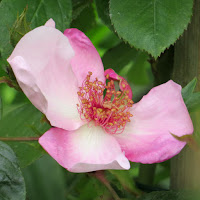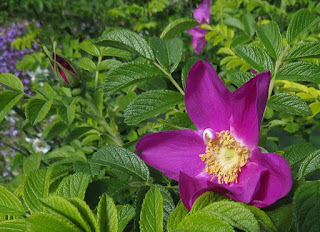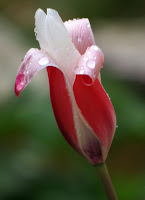"Time ceased, as if the spring
Had been eternity...
For ever, as of old,
The sunlight and the darkness and the singing."
- Ruth Pitter
 |
| Asphodels on the edge of woodland |
It's that magical time of year when we pick a warm evening to visit the asphodel woods and I add to my picture files yet more images of these mysterious, ghostly figures haunting the shadows. In the distance, there's usually a nightingale's song or a cuckoo's call lending further enchantment to the scene.
 |
| A bi-coloured hawthorn tree |
A flush of warm weather at the beginning of April eventually gave way to days of piercingly bright sunshine and an equally eye-watering cold wind, thanks to the relentless north-easterly which scoured the fields white and tore young leaves from their branches.
Luckily most of our native blossom was tenacious enough to hang on, making a blinding display against blue skies.
The 'may' trees come out early here, decorating hedgrows and scenting the air with a slightly astringent tang that enlivens the senses.
Each day brings new surprises as soil spaces gradually fill up in the beds, lessening the opportunity for weeds to grow, and we struggle to recall exactly what is planted where.
 |
| Paulownia tomentosa aka the Foxglove Tree |
Our friends from a neighbouring valley, whose garden I photographed in March, rang to say that their paulownia was in full bloom if I wanted to take its picture.
This is already a tall tree with slender spreading branches and the brown buds have now opened to reveal downward pointing 'fingers' of lilac flowers, which are faintly scented.
Its leaves, too, are well-shaped with heavily etched veins adding to its exotic appearance.
Nearby was an ebullient lilac tree, covered in flowers of an almost identical shade. Last year our lilacs were noticeably lacking in blooms but they've more than made up for it this season and we've filled a succession of vases to enjoy the heady scent indoors.
Rose chafers
Our garden has always had an abundance of insects, including these emerald-green chafer beetles which buzz quite loudly when they're on the wing.
They don't appear to do any noticeable damage to our roses but we used to worry about the huge number of rose chafer grubs that were resident in our compost bin, having been told they were a pest which would eat through plant roots.
In this regard, we're indebted to Chris Luck of the Anglo-French website Planetepassion for putting us right some years ago when he featured pictures of this useful grub, allowing us to identify it and appreciate how it benefits the garden.
Although our soil is extremely fertile, it's odd how few worms seem to live in it. Back in England we were used to digging up worms with every clod of earth. Not so here.
What worms we do have seem to originate in the leaf-mould bin, perhaps because it stays damp there whereas the flower beds are apt to dry out quite quickly in summer.
Chafer grubs, on the other hand, relish all the green waste in our compost bin and reward us by producing finely sieved 'black gold' for recycling in the beds.
Compost
Christina always dreads the moment when I suggest 'turning the compost' as she does most of the heavy forking, while I busy myself chucking out stones, walnuts, thick twigs and potatoes, which tend to grow shoots rather than break down efficiently.
It may take us a couple of days to finish the sorting process but it provides us with great satisfaction when we shovel the completed, crumbly compost into a fresh bin!
Walnuts
This is already a tall tree with slender spreading branches and the brown buds have now opened to reveal downward pointing 'fingers' of lilac flowers, which are faintly scented.
Its leaves, too, are well-shaped with heavily etched veins adding to its exotic appearance.
Nearby was an ebullient lilac tree, covered in flowers of an almost identical shade. Last year our lilacs were noticeably lacking in blooms but they've more than made up for it this season and we've filled a succession of vases to enjoy the heady scent indoors.
 |
| More swags for the sitting room |
 |
| Rose chafers (Cetonia aurata) |
Our garden has always had an abundance of insects, including these emerald-green chafer beetles which buzz quite loudly when they're on the wing.
They don't appear to do any noticeable damage to our roses but we used to worry about the huge number of rose chafer grubs that were resident in our compost bin, having been told they were a pest which would eat through plant roots.
 |
| Rose chafer grub - a good guy! |
Although our soil is extremely fertile, it's odd how few worms seem to live in it. Back in England we were used to digging up worms with every clod of earth. Not so here.
What worms we do have seem to originate in the leaf-mould bin, perhaps because it stays damp there whereas the flower beds are apt to dry out quite quickly in summer.
Chafer grubs, on the other hand, relish all the green waste in our compost bin and reward us by producing finely sieved 'black gold' for recycling in the beds.
 |
| Maturing compost, turned and mixed, with some water added before being returned to the bin (with grubs) for another few months of natural break-down |
Christina always dreads the moment when I suggest 'turning the compost' as she does most of the heavy forking, while I busy myself chucking out stones, walnuts, thick twigs and potatoes, which tend to grow shoots rather than break down efficiently.
It may take us a couple of days to finish the sorting process but it provides us with great satisfaction when we shovel the completed, crumbly compost into a fresh bin!
Walnuts
 |
| Plenty of greenery now but walnut trees are slower to come into leaf |
 |
| Early walnut leaves |
If it wasn't for having a digital camera with a telephoto lens I might easily miss some of the finer details that nature provides when plants are waking up again.
I first noticed the colour of these emerging leaves when I was trying to focus on dangling walnut catkins which were then more obvious.
These striking tonal effects last but a day or two and need strong sunlight to show up the full range of tints. By next week they'll probably have succumbed to a uniform shade of green!
 |
| Quince blossom - Cydonia oblonga found in orchards or even growing semi-wild on the edge of local woods! |
Quince
Not to be confused with Japanese flowering quince (aka japonica or Chaenomeles), this is a tree of the rose family which produces exquisite cup-shaped blooms.
Gardening writer Anna Pavord describes finding these blossoms for sale in an achingly trendy Fifth Avenue store, where they could be purchased for a mere $40 a branch!
Here in rural Charente Maritime they're usually grown for their pear-shaped fruits which are high in pectin and traditionally used for making quince jelly. They're also delicious when cooked up with apples.
Caterpillars
Much as I love our insect friends, there are occasional infestations which prove they can sometimes be too much of a good thing!
Having avoided box blight over the past ten years, our little hedges have been quite badly affected by a moth caterpillar which spins webs between the branches and feeds off the leaves.
The RHS has a useful page on this particular pest, Cydalima perspectalis, which we first noticed last summer. We sprayed it with a product from our local store but unfortunately it came back this year, worse than ever.
So we've resorted to carefully spraying with Rose Clear Ultra, bought in the UK recently and probably banned in the EU... Controversial, I know, but something I've used successfully on roses and other plants, in very localised situations. It may call for two applications to really eradicate the caterpillars this time.
We had a graphic illustration of just how bad these infestations can get if you don't intervene early enough.
Walking past a nearby hedgerow, where we regularly admire the bushes of spindleberry in autumn, we saw with horror how they were festooned with white webbing.
Closer inspection revealed that the webs were full of caterpillars with black spots, later identified as larvae of the European Spindle Ermine Moth, a well-known pest which can cover euonymus shrubs over a huge area.
Check out Google Images for some very scary photo's!!
Roses
On a calmer note, it's lovely to watch the first roses appearing in various parts of the garden, not just in sunny areas but also in semi-shaded spots beneath trees.
This is where the hedging rose, Rosa rugosa, comes in useful because it flourishes in sun or part-shade, tolerant of dry soil - and even, dare I say it, a certain amount of neglect!
I've noticed a few aphids on some of its tough little leaves but they are soon shaken off and its buds don't tend to attract greenfly like other, more highly bred roses.
You can almost tell from looking at this flower that it will be beautifully scented... we have at least three varieties of rugosas and they are all strongly perfumed.
If I have any gripe, it would be that these velvety blooms just don't last long enough.
Popular on the seasonal menu... a tranquil early-morning scene!
 |
| Box hedge blighted by caterpillars |
Much as I love our insect friends, there are occasional infestations which prove they can sometimes be too much of a good thing!
Having avoided box blight over the past ten years, our little hedges have been quite badly affected by a moth caterpillar which spins webs between the branches and feeds off the leaves.
The RHS has a useful page on this particular pest, Cydalima perspectalis, which we first noticed last summer. We sprayed it with a product from our local store but unfortunately it came back this year, worse than ever.
So we've resorted to carefully spraying with Rose Clear Ultra, bought in the UK recently and probably banned in the EU... Controversial, I know, but something I've used successfully on roses and other plants, in very localised situations. It may call for two applications to really eradicate the caterpillars this time.
 |
| Euonymus Caterpillar Yponomenta cagnagella |
Walking past a nearby hedgerow, where we regularly admire the bushes of spindleberry in autumn, we saw with horror how they were festooned with white webbing.
Closer inspection revealed that the webs were full of caterpillars with black spots, later identified as larvae of the European Spindle Ermine Moth, a well-known pest which can cover euonymus shrubs over a huge area.
Check out Google Images for some very scary photo's!!
 |
| Rose 'Astronomia' - a newcomer bred by French growers Meilland |
On a calmer note, it's lovely to watch the first roses appearing in various parts of the garden, not just in sunny areas but also in semi-shaded spots beneath trees.
This is where the hedging rose, Rosa rugosa, comes in useful because it flourishes in sun or part-shade, tolerant of dry soil - and even, dare I say it, a certain amount of neglect!
 |
| Rosa rugosa - robust, good for mixed hedges and easily raised from rooted suckers |
You can almost tell from looking at this flower that it will be beautifully scented... we have at least three varieties of rugosas and they are all strongly perfumed.
If I have any gripe, it would be that these velvety blooms just don't last long enough.
 |
| Marais lambs bred on salt marshes along the estuary |














